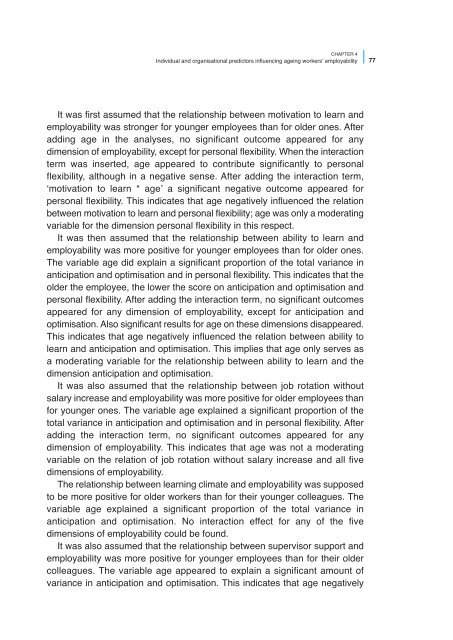Working and ageing - Cedefop - Europa
Working and ageing - Cedefop - Europa
Working and ageing - Cedefop - Europa
Create successful ePaper yourself
Turn your PDF publications into a flip-book with our unique Google optimized e-Paper software.
CHAPTER 4<br />
Individual <strong>and</strong> organisational predictors influencing <strong>ageing</strong> workersʼ employability 77<br />
It was first assumed that the relationship between motivation to learn <strong>and</strong><br />
employability was stronger for younger employees than for older ones. After<br />
adding age in the analyses, no significant outcome appeared for any<br />
dimension of employability, except for personal flexibility. When the interaction<br />
term was inserted, age appeared to contribute significantly to personal<br />
flexibility, although in a negative sense. After adding the interaction term,<br />
ʻmotivation to learn * ageʼ a significant negative outcome appeared for<br />
personal flexibility. This indicates that age negatively influenced the relation<br />
between motivation to learn <strong>and</strong> personal flexibility; age was only a moderating<br />
variable for the dimension personal flexibility in this respect.<br />
It was then assumed that the relationship between ability to learn <strong>and</strong><br />
employability was more positive for younger employees than for older ones.<br />
The variable age did explain a significant proportion of the total variance in<br />
anticipation <strong>and</strong> optimisation <strong>and</strong> in personal flexibility. This indicates that the<br />
older the employee, the lower the score on anticipation <strong>and</strong> optimisation <strong>and</strong><br />
personal flexibility. After adding the interaction term, no significant outcomes<br />
appeared for any dimension of employability, except for anticipation <strong>and</strong><br />
optimisation. Also significant results for age on these dimensions disappeared.<br />
This indicates that age negatively influenced the relation between ability to<br />
learn <strong>and</strong> anticipation <strong>and</strong> optimisation. This implies that age only serves as<br />
a moderating variable for the relationship between ability to learn <strong>and</strong> the<br />
dimension anticipation <strong>and</strong> optimisation.<br />
It was also assumed that the relationship between job rotation without<br />
salary increase <strong>and</strong> employability was more positive for older employees than<br />
for younger ones. The variable age explained a significant proportion of the<br />
total variance in anticipation <strong>and</strong> optimisation <strong>and</strong> in personal flexibility. After<br />
adding the interaction term, no significant outcomes appeared for any<br />
dimension of employability. This indicates that age was not a moderating<br />
variable on the relation of job rotation without salary increase <strong>and</strong> all five<br />
dimensions of employability.<br />
The relationship between learning climate <strong>and</strong> employability was supposed<br />
to be more positive for older workers than for their younger colleagues. The<br />
variable age explained a significant proportion of the total variance in<br />
anticipation <strong>and</strong> optimisation. No interaction effect for any of the five<br />
dimensions of employability could be found.<br />
It was also assumed that the relationship between supervisor support <strong>and</strong><br />
employability was more positive for younger employees than for their older<br />
colleagues. The variable age appeared to explain a significant amount of<br />
variance in anticipation <strong>and</strong> optimisation. This indicates that age negatively

















